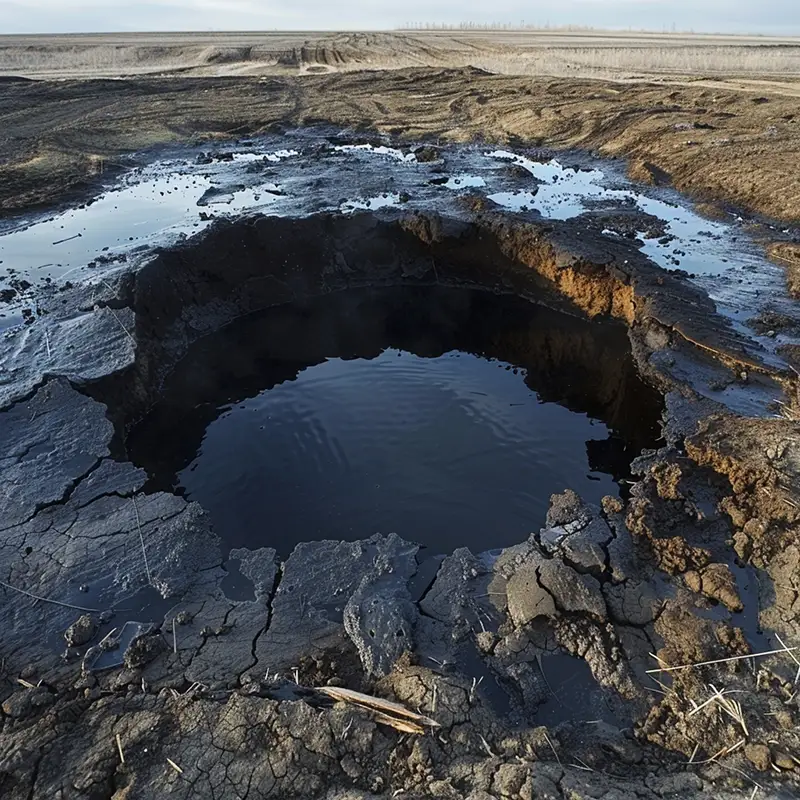What are Subsurface Rights?

When you buy land, it’s easy to assume you own everything — the soil beneath your feet, the crops on the surface, and even the resources buried deep underground. But in many cases, subsurface rights — which refer to the legal ownership of underground resources like oil, gas, and minerals — are not included when you purchase surface land. This means that someone else may legally own and control what’s beneath your property, even if you hold the deed to the land itself.
That’s where subsurface rights come in — and for property owners, investors, and energy developers, understanding these rights is more than just legal jargon. It’s about protecting your assets, unlocking hidden value, and avoiding costly surprises.
At B.J. Kadrmas Inc., we’ve spent over 40 years helping clients across North Dakota, Montana, South Dakota, and beyond make sense of complex mineral and surface ownership. Whether you’re a landowner curious about oil and gas rights or a company planning a pipeline route, we’re here to provide clear, honest guidance.
In this guide, we’ll walk you through exactly what subsurface rights are, how they affect your land ownership, and why they matter more today than ever before. If you want clarity, confidence, and peace of mind when it comes to what’s beneath your land — you’re in the right place.
What Are Subsurface Rights?
Subsurface rights are the legal rights to own, access, and control the natural resources located beneath a piece of land — including oil, natural gas, coal, metals, and other minerals. If you hold subsurface rights, you have the authority to explore, extract, lease, or sell those underground resources — even if you don’t own the surface of the land itself.
What makes subsurface rights unique is that they can be completely separate from surface rights. You might own a property and use it for farming or development, but someone else could legally own the rights to everything beneath your feet — and they may even have the right to access those resources.
At B.J. Kadrmas Inc., we often explain it this way: surface rights give you ownership of what’s on the land — homes, crops, fences, etc. Subsurface rights govern what’s underneath — minerals, energy deposits, and valuable geological materials.
In many cases, these rights can be sold, leased, inherited, or divided, just like any real estate asset. And in resource-rich regions like North Dakota or Wyoming, subsurface rights can actually be more valuable than the surface land itself.
Understanding who owns which set of rights — and how they interact — is crucial. That’s why landowners, mineral owners, law firms, banks, and energy companies turn to us at B.J. Kadrmas Inc. to research, clarify, and navigate these often complex property situations with confidence and integrity.
Landowners vs. Mineral Owners: Who Controls the Underground?
A common misconception is that when someone buys land, they automatically own everything under the surface. However, this is only sometimes true. The ownership of land can be divided into two distinct estates: surface estate and mineral estate. These estates can be owned by different parties, which often leads to confusion about who controls what.
Landowner: The landowner typically holds surface rights, which means they have control over the physical surface of the property. They can build homes, plant crops, or use the land for recreational purposes. However, their rights generally stop at the surface and do not extend to the minerals beneath the land.
Mineral Owner: The mineral owner, on the other hand, holds the subsurface or mineral rights, which means they control the natural resources beneath the surface. These resources include oil, gas, coal, and other valuable minerals. The mineral owner has the right to explore for and extract these resources, regardless of who owns the surface.
This division can result in situations where the landowner cannot control what happens underground. For example, if the mineral rights are leased to an energy company, that company can legally access the property to drill or mine provided they do so within the legal limits and offer fair compensation for surface disruption. In most cases, mineral rights take precedence over surface rights, meaning the mineral owner’s right to access the subsurface resources can supersede the surface owner’s right to use the land.
This distinction is particularly important for landowners to understand, as they may not have any rights to the potentially lucrative resources beneath their property unless they also own the subsurface rights.
Subsurface Rights vs. Mineral Rights
Although subsurface rights and mineral rights are often used interchangeably, there is a subtle but important distinction between the two. Mineral rights refer specifically to the ownership and control of the minerals found beneath the surface of a property. These minerals typically include valuable resources such as oil, natural gas, coal, and metals like gold or uranium. Mineral rights give the owner the authority to explore, extract, and sell these specific resources.
On the other hand, subsurface rights is a broader term. It encompasses not only mineral resources but also other materials and resources found underground, including non-mineral resources. For example, subsurface rights may cover groundwater, geothermal energy, and even fossil fuels like methane trapped in underground formations.
Why the Distinction Matters
This means that while all mineral rights holders are subsurface rights holders, not all subsurface rights are necessarily tied to minerals. Subsurface rights could also grant access to resources like geothermal energy, which is becoming increasingly valuable in renewable energy sectors. Additionally, they could include the right to store substances like natural gas in underground formations or to use underground spaces for carbon capture and storage (CCS).
If you own subsurface rights, you have the legal authority to lease, sell, or develop the resources beneath the surface of the property. This could mean granting permission to an energy company to drill for oil or gas or allowing geothermal energy extraction. The ownership of these rights provides access to a wide array of underground assets, giving the holder significant flexibility and financial opportunities.
Learn how B.J. Kadrmas Inc. helps with Title Research and Mineral Appraisals to support your land and resource decisions.

Why Are Subsurface Rights Valuable Assets?
The value of subsurface rights lies in the natural resources hidden beneath the land. These resources—whether they are oil, gas, coal, or minerals—have immense economic potential. With growing global demand for energy and raw materials, subsurface resources are considered highly valuable assets. The limited nature of these resources further drives up their worth, particularly as certain reserves become harder to access or more in demand.
For example, if oil or natural gas is discovered beneath your property, an energy company may approach you with an offer to lease your subsurface rights. By leasing your rights, the company gains the ability to extract the resources, while you, as the rights holder, receive compensation for granting them access.
This financial compensation can come in several forms:
Bonus Payments: These are upfront, one-time payments made when the lease agreement is signed. They serve as an incentive for the rights holder to allow exploration and potential extraction.
Royalties: Ongoing payments that are typically calculated as a percentage of the profits generated from the production of the resources. This ensures that the subsurface rights holder continues to benefit financially over the life of the resource extraction operation.
Lease Payments: These are payments made throughout the lease, regardless of whether any resources are extracted. In some cases, landowners may receive consistent payments simply for leasing the subsurface rights, even if no production takes place.
Subsurface rights are particularly valuable because the resources they grant access to are finite. As global demand for energy resources such as oil and gas increases, so does the value of the rights to those resources. Additionally, minerals like uranium or copper, which are critical for various industries and technologies, further add to the economic value of subsurface rights.
Beyond the immediate financial gain, holding subsurface rights also presents opportunities for long-term income. Royalties from resource extraction can provide a continuous revenue stream, while leasing options allow the rights holder to profit without having to sell the underlying assets outright. This flexibility makes subsurface rights a significant asset for landowners and investors alike.
How Subsurface Rights Work
Subsurface rights function similarly to other types of real estate assets—they can be bought, sold, leased, or inherited. What makes subsurface rights unique is that they are often separated from surface rights, meaning that the ownership of what’s above the ground and what’s beneath it can belong to different parties. For example, you might own the surface rights to a property, allowing you to use and develop the land, but someone else may hold the subsurface rights, giving them control over valuable resources like oil or minerals located underground.
The Dominance of Mineral Rights
This separation can lead to complex legal scenarios. One key issue is that, in most cases, mineral rights are dominant over surface rights. This legal principle, known as the dominance of mineral rights, means that the mineral owner has the right to access and extract the subsurface resources, even if doing so disrupts the surface owner’s use of the land. For instance, if the mineral owner or a company with a lease wants to drill for oil, they typically have the legal authority to access the surface to perform the extraction, provided they follow certain regulations and offer compensation for any surface disruption.
Legal Variations by Region
Both landowners and subsurface rights holders need to understand the laws governing these rights, as they vary significantly depending on the country, state, or region. In some countries, subsurface resources are automatically owned by the government, which can control and regulate access. In contrast, private ownership of both surface and subsurface rights is common, though there are federal and state regulations in place to govern extraction practices and ensure environmental and public safety.
If you own subsurface rights, it’s crucial to be aware of these laws and understand how they may impact your ability to use or transfer those rights. Similarly, if you’re a surface owner without subsurface rights, you should be mindful of the potential for resource extraction activities on your property.

How to Profit from Subsurface Rights: Lease, Sell, or Develop
If you own subsurface rights or are looking to acquire them, there are several options for how you can manage and profit from these valuable assets. Each option comes with its own set of advantages, depending on your goals, level of involvement, and risk appetite.
1. Leasing Your Rights
One of the most common and potentially profitable ways to manage subsurface rights is by leasing them to an energy or mining company. When you lease your subsurface rights, you retain ownership, but you grant the lessee (often an oil, gas, or mining company) the right to explore and extract the resources.
This arrangement is beneficial for several reasons:
- You receive bonus payments when the lease is signed, which is an upfront payment made before any extraction begins.
- If extraction occurs, you also receive royalties—a percentage of the profits from the sale of the extracted resources.
- In some cases, even if no extraction happens, you may still receive lease payments, which compensate you for allowing the company to hold the rights during the lease period.
Leasing your rights is an attractive option for subsurface rights holders who want to benefit financially without selling their rights outright. It also allows you to retain control over the long-term ownership of the resources.
2. Selling Your Rights
If you’re looking for an immediate, lump-sum payment, you can choose to sell part or all of your subsurface rights. This can be a lucrative option, especially if the resources are known to be valuable. Selling your rights transfers ownership of the subsurface resources to the buyer, and you will no longer be entitled to any future profits from extraction or leasing.
Many landowners opt to sell a portion of their rights while retaining some, allowing them to benefit from both a lump-sum payment and potential future royalties. However, it’s important to weigh the long-term consequences of selling all your rights, as you will forfeit any future claims to those resources once the transaction is complete.
3. Participating in Mineral Development
For subsurface rights holders looking for more involvement—and potentially higher returns—there is the option of participating directly in mineral development. This approach allows you to become a working partner in the exploration and extraction of the resources on your land, which can be particularly attractive if you’re confident that the resources are significant.
By taking on a working interest, you share both the profits and costs associated with the extraction process. This means that while you stand to earn a higher percentage of the revenues, you are also responsible for a portion of the operational and exploration costs. This method is riskier and requires more financial investment upfront, but it can yield significant long-term returns if the resource extraction is successful.
Many subsurface rights holders choose this path when they want to be more than passive investors and can influence how and when the resources are extracted.
How to Buy Subsurface Rights
Acquiring subsurface rights is a process that requires careful planning, thorough research, and often, legal assistance. Whether you’re looking to invest in oil, gas, or other mineral resources, purchasing subsurface rights can provide long-term financial benefits. However, the process is not as straightforward as buying surface land and comes with its own set of complexities.
Here are the essential steps to follow when purchasing them:
1. Identify Available Rights
The first step is to find properties where subsurface rights are available for purchase. This may involve researching areas with known mineral deposits or regions where oil and gas development is active. Several online platforms and government databases list subsurface and mineral rights for sale, giving buyers access to a wide range of properties and rights across various locations. These platforms can help you identify rights for oil, gas, coal, and other valuable minerals.
It’s also a good idea to work with land professionals or energy consultants who specialize in subsurface rights transactions. These experts can help you pinpoint opportunities in resource-rich areas and provide insights into potential risks or benefits associated with a particular property.
2. Understand State and Federal Laws
One of the most critical aspects of buying subsurface rights is understanding the legal framework that governs them. Laws surrounding subsurface rights vary significantly by state and jurisdiction, which means what’s legal in one region may not apply in another. Some key factors to consider include:
Ownership laws: In some states or countries, certain minerals may be considered government property, limiting the extent of your rights. For example, in the U.S., private individuals can own both surface and subsurface rights, but specific laws can dictate how these resources are extracted and sold.
Extraction regulations: Many states have strict regulations on how resources like oil and gas can be extracted to ensure environmental safety and to manage resources sustainably. You’ll need to understand these regulations to determine the feasibility and legality of extraction on the property you are considering.
Permits and drilling rights: Some states require permits or licenses for drilling, mining, or other resource extraction activities. Ensuring you are familiar with these requirements before purchasing subsurface rights will help you avoid legal issues down the road.
It’s crucial to consult a legal expert who is familiar with local subsurface laws. An attorney specializing in mineral rights or energy law can guide you through the legal complexities, ensuring that you don’t run into unexpected regulatory barriers after the purchase.
3. Negotiate Terms
Once you’ve identified a property with subsurface rights for sale and have done your research, the next step is to negotiate the purchase terms. This stage can be intricate, as it involves several key factors that will determine the success of your investment:
Price: The price of subsurface rights can vary significantly depending on the type of resources present, the location, and market demand. You’ll need to assess the value of the rights carefully, factoring in the current and future demand for the specific resources available.
Type of Minerals: When negotiating, make sure you clearly define which minerals or resources are included in the purchase. In some cases, only specific minerals (such as oil or gas) may be part of the agreement, while other valuable resources (like coal or water) could be excluded.
Extraction Methods: Extraction methods are another critical consideration. If the property includes oil or gas, for example, you may need to negotiate whether hydraulic fracturing (fracking) or horizontal drilling methods are allowed. Different extraction methods come with varying environmental impacts and cost structures, so it’s essential to understand these in the context of your goals.
Having a legal expert or land professional involved during negotiations is highly recommended to ensure the terms are fair and in your best interest. They can help you clarify technical aspects, draft the agreement, and review the contract to ensure that all necessary details are included, such as any potential restrictions or contingencies on the use of the subsurface rights.
Conclusion
Subsurface rights offer a powerful opportunity for long-term income and asset control, but they also come with legal and operational complexities. Whether you’re leasing, selling, or exploring ownership options, it’s critical to understand how these rights impact your property and financial future.
At B.J. Kadrmas Inc., we specialize in guiding landowners, banks, and energy companies through title research, mineral appraisal, and right-of-way acquisition. Reach out to us today to learn how we can help you unlock the full value of what lies beneath your land.